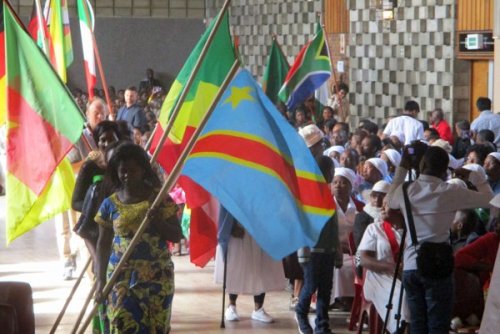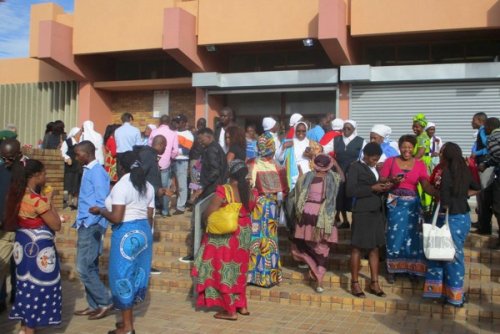“Our moms have worked all their lives as housekeepers. We grew up in Khayelitsha, Cape Town’s largest black township, and we are now starting careers as executives... Deep down, we are a peaceful and happy people. We can make jokes even about the worst news. The leaders calling for revolt are demagogues driven by political calculations, we are not fooled by their game.” Chumani Bontsa, a fisheries inspector, explains the opinion of a small group of young professionals. This reflects the views of a number of black citizens who grew up after the end of apartheid. These young adults believed in change and took their lives in hand. Universities have opened their doors wide, an affirmative action policy has given access to employment, thousands of homes have been built... The effort has been very considerable.
This contrasts with the often dramatic picture reflected by the country’s media, which is filled with daily violence, corruption scandals, political disputes... It is true that with a disparity between rich and poor among the greatest in the world, a very high crime rate, governing authorities which are unsure of themselves, there are still many challenges for South Africa. Some may ask the question: 25 years after the end of apartheid, has the great undertaking of integration ground to a halt? There is no longer a common fight to cement people together. The great work of the Truth and Reconciliation Commission has not managed to bring the extent of healing which many hoped for. Old wounds and new challenges are entwined: slavery, forced displacement, segregation, exploitation, inequalities, lack of governance expertise in a young democracy, closure of several mines and other economic uncertainties...

The social reality in Cape Town is emblematic of that of the country. Slow evolution and economic inequalities mean that different communities still live apart from each other. Schools, churches, leisure activities are compartmentalized. Sport or music are practised in parallel... Cape Town is a social mosaic of which each piece bears witness to some of the failed encounters which have marked the history of the peoples. Their claim for land restitution and for the recognition of their identity has crystallized an awakening of the original native peoples, the Khoi and the San, who were once driven out.
The several thousand people who were shipped to the Cape as slaves in the 17th and 18th centuries were brought from Madagascar, Mozambique and the East African coast, India and from the islands of the East Indies such as Sumatra, Java, the Celebes, Ternate and Timor. They are a part of the ancestry of the so-called Coloured people who constitute almost 50% of the population of the Western Cape province, of which Cape Town is the capital. The Coloured people were uprooted a second time – over the course of 30 years of so – when they were forcibly displaced by the implementation of the Group Area Act of 1950, and saw their homes destroyed.
Xhosa people continue to come to Cape Town every year in their thousands looking for a better life than they have in the former Bantustans of Transkei and Ciskei. There are also many refugees and immigrants from all over Africa stranded at the tip of the continent. Some are highly qualified professionals, teachers and doctors. Yet many eke out a living in the informal economy. They are accused of taking jobs from local young people by accepting lower wages. They are sometimes victims of violence.
In Cape Town, the descendants of Afrikaners reside mainly in the Northern Suburbs, whereas the Southern Suburbs are an area with those mostly of British descent. The Cape Flats, an immense zone of sandy dunes in the middle, are covered by the Coloured and Black townships. In the the aftermath of the Apartheid system, this reflects a division of human communities characterised by different ways of thinking, different world-views, different ways of relating to one another. There is a wide range. At one extreme, there are those who have just left the village and its complex and conservative framework, with a hierarchical culture, the authority of the elders, initiation rites, dowry negotiations and funeral rituals. This system ensures stability and a strong clan and family solidarity. At the other extreme are those who grew up in a secularised, individualistic environment, accustomed to constant questioning and the exploration of all possibilities. Spaces of encounter and integration are few. But many realise that, “either we shall succeed together, or else we shall explode together!”

South Africa offers us a gift by the way in which it poses questions to us. This deeply bruised and fragmented humanity, where there are all kinds of tensions, says to us: What is it that builds up a moral sense in people and societies? What can build unity, and a sense of the dignity and unique value of every human being? The answer is not to be found in books or conferences, but in the people who, in this situation, move forward loving others, in those who give life, care for it, repair it, believe in it. Highlighting the lives of such people is therefore essential to sustain the hope of young people.
This is where we should look for South Africa’s most precious diamonds: the people who bear witness to the generosity of the human heart. We can be sorrowed by the divisions and the selfishness we see, but we must not forget to acknowledge the extraordinary capacity of different groups to coexist peacefully, as well as the resilience of the people who have passed through the trials of history.
Despite attempts at defamation and criticism towards him, the figure of Mandela remains a strong reference. His twin training – in traditional village life on the one hand, and in academic law studies on the other – as well as the 27 years of imprisonment that did not destroy his faith in God or his trust in the human being, resulted in a mature wisdom allowing him to embody the aspirations of many and to defuse the fears of others in the march towards the end of apartheid and the birth of a democracy.
The 2019 September pilgrimage of trust is an opportunity to discover the Nelson Mandelas of today. There are a good number of projects, led by NGOs, churches, or simply small groups of individuals which put solidarity into practice.
Mr. and Mrs. September, live with a small pension in Athlone at the entrance to the Cape Flats. Twice a week they cook a large pot of food, and from the pavement in front of their home give some hot food to the most needy.
Mr. Matthew Kotze, who has been homeless himself in the past, leads the “Loaves and Fishes” house in Salt River. He devotes all his energy, patience and experience to welcoming and reintegrating marginalized people.
Pastor De la Harpe introduces himself as a converted racist. On 25 December in Bloemfontein in the garden of the Dutch Reformed Church of the Two Towers, he coordinated, with thirty volunteers drawn from all communities, a Christmas meal for 500 poor people, who all left afterwards with an extra packet of provisions.
In the South African context any invitation to cross barriers in order to experience fraternity, to share hope, to seek a source of communion, is very relevant. Celebrating the one God in praise and silence together, allows us to glimpse that renewing our community with one another is possible.

Making a place for everyone, allowing people to meet and share in depth, in hospitality and worship is a venture whose stakes go far beyond all the practical preparations to be made for a meeting, with all its problems to solve, permissions to obtain, the contracts to draw up. It is a contribution to celebrating and supporting the hope which South Africa already embodies.
 TAIZÉ
TAIZÉ